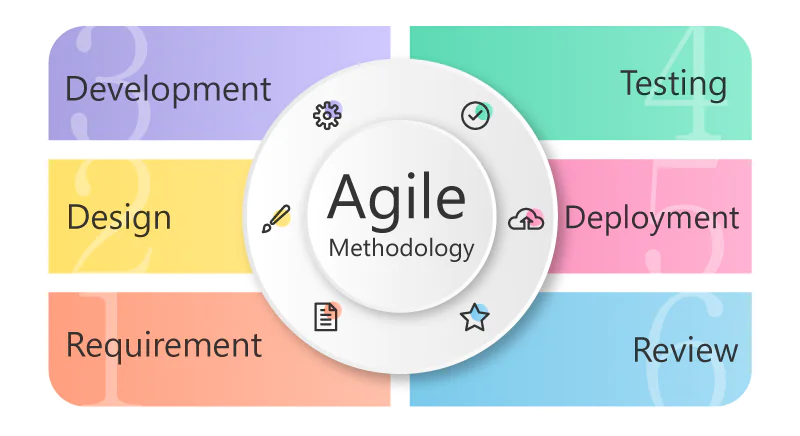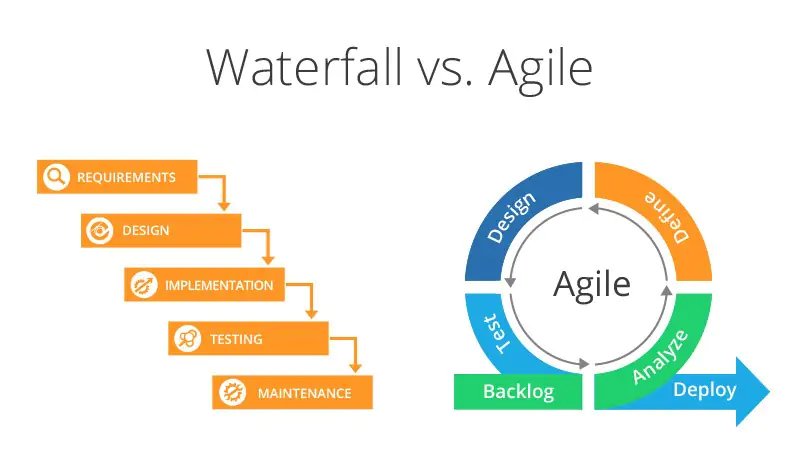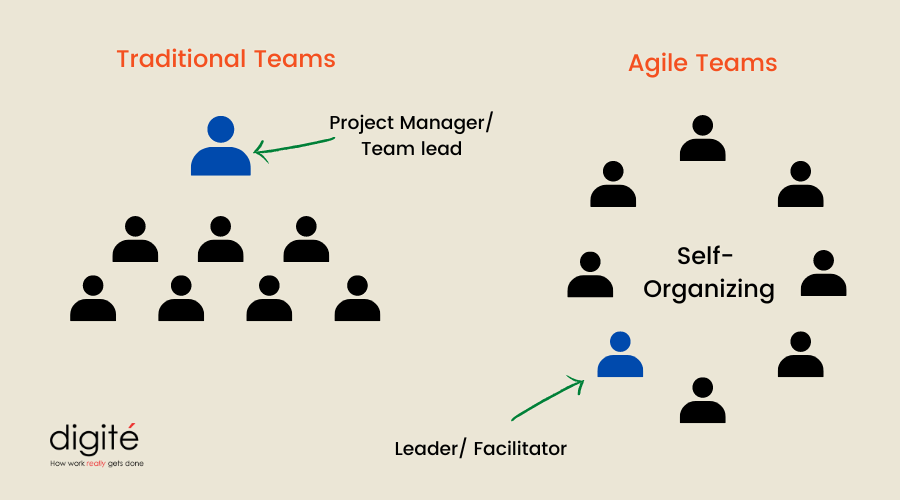This brings us to Agile Project Management, a new-age approach to project management that incorporates the values and principles of the Agile methodology.
It is an iterative, empirical approach to Project Management where cycle times are much shorter and tasks are reactive.
There are a handful of more specific differences between Traditional Project Management and Agile Project Management. This includes the following:
Traditional Project Management is concerned with planning every detail at the beginning of the project. All of the details of the tasks are meticulously planned and handed to whoever on the team is responsible for them.
Meanwhile, the planning process in Agile Project Management is at a higher level. This means that the managers are not as concerned with the granular details during each phase of the project. Instead, tasks and resources are given to their respective point persons within the team and they are then trusted to deliver.
Traditional project planning is a “high-stress” environment where the “iron-triangle” triple constraints of scope, effort, and schedule had to be estimated and pre-committed to. Making any changes to the scope after the start of the project is an anathema and usually requires a very formal change management process (described further down) to be put in place. Essentially, project managers and teams were required to make serious business commitments for a project when they knew the least about the project.
Agile Project Management fundamentally changes this by removing the “fixed scope” constraints, making it a fixed-effort and fixed-schedule process (as described later) while keeping scope variable. Agile methods focus on delivering a working deliverable every 2-3 weeks. By reducing the duration and increasing the frequency of these deliverables, Agile Project Management tries to reduce the uncertainty of the final deliverable – by providing product owners and stakeholders frequent opportunities to give feedback on what has been done and make changes as needed to ensure that the final deliverable meets the (ever-changing) requirements of the stakeholders.
Traditional Project Management frameworks such as Waterfall are sequential. This means that once one phase of the project ends, the next one begins, culminating in a big outcome at the end of the project.
This is not the same as in Agile Project Management, which is iterative. Instead of sequential phases that culminate with the release of the product, Agile teams work in sprints leading to the release. After the release, Agile teams then take in feedback from the customer then improve upon the product during the next sprint to release a new and improved iteration. This iterative process ensures that the product is continually improving and that the business is always meeting the customer’s needs.
In Traditional Project Management, Change Management is more rigid. When requirements change during the project life cycle, there is usually a formal process to declare the need for change known as a change request. This request is then either approved or rejected.
Meanwhile, Change Management is continuous and ongoing within an Agile environment, without the need for formal processes. Change is more welcomed within an Agile project team, whereas it is opposed in a traditional environment.
Big Design Up Front, or BigDUF, is an approach where a team creates a product, usually a website, app, or some form of software, and then releases it into the market. This way of working relies on prediction and was standard practice before the popularity of Agile.
With Agile, instead of predicting what the customer wants to see in a product before releasing it, the project teams actively involve the customer in the development and improvement of the product. This collaborative approach to Project Management ensures that the team produces a product that customers will want to purchase.
One of the biggest differences between Traditional Project Management and Agile Project Management are the respective roles of the team members.
The following are the Traditional Project Management roles:
The Project Manager has the primary responsibility of overseeing the completion of the project. Their role is to ensure that all of the objectives for the project are met while ensuring that resources remain within the established budget.
The team members are the individuals who will be working on the project. Their roles and responsibilities can vary.
The Project Sponsor is one of the key stakeholders for the project. Typically, this role is filled by someone from senior management. They work closely with the Project Manager to assist in resolving any issues that the team encounters in delivering the project.
The executive sponsor typically comes from high ranking management. They are the ultimate decision maker, above even the project manager, and have the final say on everything.
The analyst has the responsibility of defining the organization’s needs and recommending solutions to any problems that the team encounters. This person also has the role of advising the project manager on the objectives of the project.
This role has two main responsibilities within an Agile team. The first is to introduce Agile to the rest of the team while also ensuring that the team members work accordingly with Agile’s core values and principles.
The second role of the Scrum Master is that of a leader. They are responsible for ensuring that the team stays on track during their sprints as well as resolving any issues that may arise.
Agile is focused on delivering value to the customer, and the Product Owner is the voice of the customer to the team. This person is responsible for defining the goals for each sprint, managing the team’s backlog, while also representing the customer or internal stakeholders during meetings.
These are the people within a team that are in charge of executing the work during each sprint. While not as specialized as the roles of Scrum Master and Product Owner, they are essential for delivering the project from start to finish.
Unlike team members, stakeholders aren’t necessarily involved with the delivery of a project. Instead, they are to be kept up-to-date on the latest developments, review and approve changes, while also providing valuable feedback during sprint retrospective meetings.
An Agile project has 6 steps that have to be followed. These steps are:
The first step to executing a project is to plan how you’re going to deliver it. This step is about understanding the end goal and how it will be achieved.
If you’re looking for a guide to creating a project plan, check out our article on 7 Simple Steps to Making an Effective Project Plan.
After the planning phase, many Agile teams often create a project roadmap. This is a breakdown of what your team needs to accomplish to achieve the end goal. This roadmap decides the team’s backlog, deliverables, and product features. It can be a great way to provide everyone a snapshot of the project highlights and its status.
In traditional project management, there is typically one release at the end of the project cycle. However, Agile Projects are broken down into multiple iterative releases using shorter development cycles, called sprints.
4. Sprint Planning & Demo
Sprints are typically 2-3 week cycles of delivering some working deliverable. During Sprint Planning, the product owner and the team decide what can be taken up in the upcoming sprint. This is done based on their review of the groomed/ prioritized product backlog.
At the end of each sprint, the team gives a demo of whatever has been delivered in the sprint to the product owner – and any other stakeholders who may be interested – and collects feedback. Any incomplete work/ issues/ defects found are then added to the backlog, to be prioritized for the next set of sprints.
Ceremonies are meetings that take place at a certain cadence. Their purpose is to help project teams through planning, tracking, and engaging with their stakeholders. These include the following:
These are short, 15-minute meetings done during the sprints. These meetings are for team members associated with the release cycle to give their updates regarding their progress.
6. Sprint Review & Retrospective
At the end of each sprint, Agile teams will have two separate meetings.
The first of these meetings is the Sprint Review, which is focused on showing stakeholders the finished product and receiving their feedback. This is to determine whether there are additional changes that are needed for the product.
The second meeting after each Sprint is the Sprint Retrospective, which is focused on the process of the sprint. This is where team members can say what they liked and what could have been done better during the sprint. This will help inform the team of what they can improve on in the future.
Switching to Agile Project Management from traditional Project Management can bring many benefits to a project team. Here are some just to name a few:
In Traditional Project Management, the product isn’t released into the market until the end of the project. This would result in months passing before the product would be in the hands of customers, who by then may no longer have had a need for the product due to a faster competitor or waning interest. This also meant development teams would not receive feedback from customers to inform them of how the product can be improved.
Agile methods address this by drastically reducing the time to market. Instead of releasing the product at the end of the overall project cycle, it is released much earlier. Customers can then try the product and provide valuable feedback to the development team. With this feedback, the team can improve the product and then release new iterations of the product that incorporate what the customer wants.
Not only does Agile increase a company’s delivery speed, but also their ability to provide value to the customer.
One of the biggest pitfalls of Traditional Project Management is that it is potentially wasteful. Since the product is released at the very end of the project cycle, which could be months after the project has started, many factors could affect its success such as customer sentiment and competition. With traditional methods, the product may not provide value to customers by the time it is released.
One of the main benefits of Agile methods is that it reduces waste by reacting to what the customer wants instead of trying to predict them. This ensures that your product teams are working on features that they know the customer is looking for then releasing these improvements in the following iteration. This helps your organization generate more value while minimizing waste.
The goal of Agile Project Management isn’t just to release a product, but to continuously provide value to the customer. This is accomplished by finding out what they want and focusing your efforts towards providing it as quickly as possible. By continually providing value, you will build and retain a larger base of customers, which leads to more revenue and sustainable growth.
More adaptable teams
One of the main advantages of incorporating Agile principles and practices into Project Management is having more adaptable teams. Agile teams are teams that are used to adjusting to sudden changes–which are common in today’s markets. Having teams that are able to start and drop projects quickly means having teams that can better serve erratic market demands.
Happier teams
Another advantage of Agile Project Management is having happier teams. Compared to Traditional Project Management teams, Agile teams tend to have more open cultures where anyone can share their ideas. This creates a culture that encourages collaboration and teamwork. This makes team members feel like they’re trusted and helps them work with less pressure which then makes working more enjoyable.
Satisfied Customers
Keeping your customers happy should be a priority for any organization. The Agile Manifesto specifically emphasizes collaborating with your customers to provide them with a product that they need. When you cater your products to what the customers want, you’ll increase their satisfaction with your business and protect your company’s bottom line.
Transitioning to Agile Methods
Shifting from traditional ways of working to Agile means more than just incorporating daily standup meetings and working in sprints. It involves changing the way your team works and shifting your priorities from producing the best product to providing the most value to your customers.
At a higher level, it means changing the way organizations and leadership plan and execute on strategic objectives, moving to a much more iterative approach with shorter planning intervals. It means focusing more on short, intermediate and long-term horizons and planning in a more flexible, ready-to-change based on market feedback manner rather than 5 and 10-year plans and detailed estimates. It also means managing people and teams in a very different manner, focusing more on goals and objectives, and letting teams figure out how they will organize themselves and deliver on those goals and objectives.
Transitioning to Agile is not simply something that can be done for a single project, but must be bought in by the entire organization.
Before transitioning to Agile Project Management, your team needs to understand what it is and why you’re making the switch. Start by educating your team on what Agile and Agile Project Management entails and helping them make the transition gradually.
Any change can be disruptive. During the transition, your team may experience decreased productivity and effectiveness. If your teams are struggling to maintain velocity or productivity they previously had, you have to give them time to make the transition. In the long run, as long as Agile is adopted with the right approach and mindset, Agile Project Management will help deliver projects more successfully and with greater value to the business and customers.









